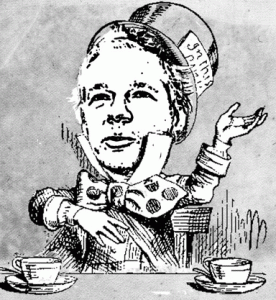Also known as “the post with the spreadsheet”, this is part one of a series of four posts analysing how I went about publishing Barefoot into Cyberspace.
I went into this project to get attention for myself as a writer of books, and to make something of a work I realised was unlikely to get mainstream sponsorship in the timeframe it needed. As such, the bottom line was not my primary target. While I was writing and publishing the book, I was earning enough money part time to make myself a living (I moved out of London to a small village in Cambridgeshire, where rents are about a quarter the price), and to fund the book’s research, promotion and (scant) publishing costs, which totalled just over £2,000.
Nonetheless, I didn’t go into this intending to lose money, and I hope that by the end of the project, I will have made back most of the money I invested (discounting labour). I’ve put up a spreadsheet detailing sales figures and profit margins, as well as some of the headline costs. I suggest you open that up while you read the rest of this post, which goes into some heady detail about the different decisions I could have made, decisions that might have ended up with me making more money than the roughly £1,000 I have made so far.
Paid-for versions of the book were made available in print or Kindle format. The print-on-demand partner, Lightning Source, offered the book at a wholesale discount to booksellers, including Amazon, or at cost price to me. Although I could set my own wholesale price, Lightning Source recommended I set it at a 55% discount on the cover price. Around the web, authors who had used Lightning Source to get their books into mainstream channels recommended taking Lightning Source’s advice, or risking unfavourable treatment from booksellers. Although I couldn’t see quite how Amazon et al would go about discriminating against authors who had set a higher wholesale price, I didn’t want to risk jinxing the project, and so I took this recommendation.
This wholesale price explains why Amazon are able to offer such deep discounts (at one point, Barefoot was offered for around £6). If you buy a copy of the book via Amazon for the full £8.99 cover price, the income to each party is massively disfavourable to the company I set up to publish the book (Barefoot Publishing):
Booksellers cut: £4.94
Lightning Source cut: £3.16
Barefoot Publishing cut: £0.89
Conversely, if you buy a copy of the book direct from me, the Lightning Source cut remains the same and Barefoot Publishing gets the remaining £5.83. The difference in cut is pretty astounding, and there are two ways I could have improved on the net revenue from print sales: upped the cover price, and encouraged people to buy direct from me.
For example, I could have upped the cover price to £12.99 – this is the cover price for Heather Brooke’s book, The Revolution Will Be Digitised, which touches on many of the same topics as Barefoot, and in a similar, reportage-like style. This would make the revenue through booksellers shake out like this:
Booksellers cut: £7.14
Lightning Source cut: £3.16
Barefoot Publishing cut: £2.69
It would also have increased my cut from direct sales to £9.21 per unit sold, taking my overall net revenues (print and Kindle) from £1,057 to £1,834 (see Scenario 1, on the spreadsheet).
So how about encouraging more people to buy from me direct? A few close friends with an inkling of how the book trade works contacted me over email to buy from me direct, but most of my direct sales came face-to-face at the launch party, the Chaos Communications Camp, and at various speaking events.
To encourage direct sales would have meant setting up my own e-commerce platform. In the week before the launch it was touch and go whether I would get listed on Amazon in time, as there’s quite a lag time between when Lightning Source add you to their catalogues and when you get listed on the Amazon website, and the flash-publishing process meant I was sailing pretty close to the wind, time-wise (there’ll be more on timing in a subsequent post). I therefore put a bit of time into creating my own e-commerce “pop-up shop” using Shopify, something I could point people to if they wanted to buy the book online. Shopify takes a 2% cut of all transactions, with a further 3% going to Paypal – still a long way from Amazon’s 55% cut. In the end, the Amazon listing came through, and to avoid incurring monthly hosting fees I deleted the Shopify platform.
I had two reasons for not taking Barefoot Publishing down the bespoke e-commerce route. The first was that, if I could help it, I didn’t want to burden myself with the hassle of fulfilling orders during the initial promotional phase of the book. And the second was that I felt that being available through Amazon would give me a kind of credibility that being available through a custom e-commerce platform wouldn’t. Because I was publishing the book outside of the traditional process, I was very sensitive to issues of credibility. Looking back, I think these latter concerns were just me being over-sensitive.
Order fulfilment would have basically meant taking details from the Shopify orders and plugging them into Lightning Source’s back end (if I had used Lulu, which has its own e-commerce platform built in, instead of Lightning Source, there would have been almost no hassle). Lightning Source charge a flat £1.25 handing fee per order, which is easily swallowed when you’re ordering 50 copies to sell at events, but has an impact when you’re making one or two unit orders. If I had increased the cover price *and* sold all my POD copies on a Merchant platform I controlled, I would have made £7.93 per POD unit, taking my total net revenues up to £2,644 (Scenario 3 on the spreadsheet).
Turning to the Kindle revenues. Selling books on Kindle is altogether much simpler than selling books on dead trees. Amazon’s Kindle desktop publishing platform makes it very simple, and I can really see how Kindle is making millionaires out of a few lucky self-publishers. Amazon offers two levels of royalties, 35% and, in some territories including the US and UK, 70%. To qualify for the higher rate, you have to pay for the bandwidth it takes to deliver the book, and you have to conform to certain pricing conditions. I chose the 70% royalties option in those territories where it was offered. The UK Kindle version had a cover price of £2.05, and the revenue distribution broke down like this:
Amazon cut: – £0.62
Delivery costs (bandwidth) – £0.26
Barefoot Publishing Cut – £1.18
I think the low cover price on the Kindle was a key sales driver. But, assuming for a moment that an increased cover price would not have dragged down sales, upping the price to the maximum allowed under the terms of the 70% royalty rate, £6.99, makes me an extra £869 (Scenario 2 on the spreadsheet).
In total, if I had increased the cover price of the print and Kindle books, and sold all print copies direct (Scenario 4), I could have made almost £3,500 – 3.5 times my actual net revenues from the project so far.
Postscript: The RIAA/unicorn double rainbow scenarios
Of course, the versions of the book that reached the most readers, by an order of magnitude, are the free versions I licensed CC-BY-SA. There will be more reflections on my choice to offer CC versions in a subsequent post. In the RIAA’s world, where every free download is a lost sale, I missed out on total net revenues of over £30,000 (Scenario 5). This is, of course, pure fantasy: there is no way to calculate the effect, positive or negative, that offering a free version has on sales of the paid-for versions.
Note that the RIAA’s view of these figures still maintains a healthy bottom line for the intermediaries in this project (but of course!). The unicorn double rainbow version of the figures (Scenario 6 on the spreadsheet), where every reader buys the book at a maximum margin for me, makes me over £100,000. Sa-weet!






